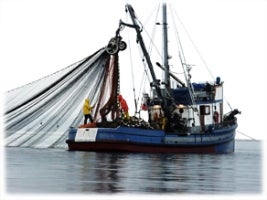Earlier this month I took a few of my staff down to Galveston, TX to meet with fishermen and get some first-hand learning on  the water and at the docks.
the water and at the docks.
We started by taking a recreational fishing trip 30 miles into the Gulf of Mexico with a fisherman friend who answered every question in the book, like “where does this bait (sardines) come from?” to “how has Hurricane Ike damage affected local fishing businesses?” We got some great insight into how for-hire fishing businesses operate and had some fun at the same time.
The next morning I got a special treat when I met a red snapper individual fishing quota (IFQ) shareholder at the docks to watch him offload 17,000 pounds of red and vermilion snapper after a six day commercial fishing trip. I was given a tour of the boat and learned some of the nitty-gritty details about running a commercial fishing business.
While I’d barely met the fishermen who were offloading, they were extremely enthusiastic about the Gulf’s IFQ program. These fishermen described the drastic difference, a very positive difference, that the IFQ made for their businesses in just the first six months.










 Just last week our fisheries policy guru, Shems Jud, attended the
Just last week our fisheries policy guru, Shems Jud, attended the  Eight months after Hurricane Ike slammed Texas’ largest fishing community, Galveston is steadily recovering from the storm. Red snapper fishermen under IFQ management kept their businesses going because they could fish later in the year and lease quota to others when they couldn’t fish themselves.
Eight months after Hurricane Ike slammed Texas’ largest fishing community, Galveston is steadily recovering from the storm. Red snapper fishermen under IFQ management kept their businesses going because they could fish later in the year and lease quota to others when they couldn’t fish themselves.  Federal regulators recently finalized rules to help regional fishery councils comply with new U.S. fisheries laws to end and prevent overfishing with “annual catch limits” and “accountability measures.” This means that tougher limits on fishing are coming, and Gulf fishery managers can take this opportunity to save fisheries and the multi-billion dollars in economic benefits they provide the region. Here’s what can be done:
Federal regulators recently finalized rules to help regional fishery councils comply with new U.S. fisheries laws to end and prevent overfishing with “annual catch limits” and “accountability measures.” This means that tougher limits on fishing are coming, and Gulf fishery managers can take this opportunity to save fisheries and the multi-billion dollars in economic benefits they provide the region. Here’s what can be done: The Gulf Council recently voted to consider adding all reef fish to the successful IFQ program already working for red snapper and coming on-line for grouper and tilefish in January. When implemented, it will be one of the largest and most modern and effective management systems in the U.S.
The Gulf Council recently voted to consider adding all reef fish to the successful IFQ program already working for red snapper and coming on-line for grouper and tilefish in January. When implemented, it will be one of the largest and most modern and effective management systems in the U.S. January marked the second anniversary of the Gulf’s red snapper IFQ program. Fortunately, fishermen, regulators and environmentalists continue to report good news compared to the decade the fishery suffered under destructive derby management (also known as a “race” for the limited number of snapper that fishermen were allowed to catch each year).
January marked the second anniversary of the Gulf’s red snapper IFQ program. Fortunately, fishermen, regulators and environmentalists continue to report good news compared to the decade the fishery suffered under destructive derby management (also known as a “race” for the limited number of snapper that fishermen were allowed to catch each year).